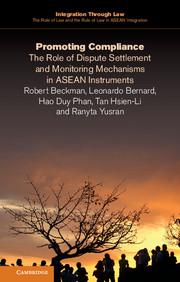Book contents
- Frontmatter
- Contents
- List of figures
- General editors’ preface
- List of abbreviations
- Introduction: overview and research rationale
- 1 The normative and theoretical underpinnings of ASEAN compliance behaviour
- 2 Dispute settlement mechanisms in ASEAN
- 3 Compliance monitoring mechanisms in ASEAN
- 4 Recommendations
- Executive summary
- Appendix 1 CIL’s observation on dispute settlement clauses in selected ASEAN agreements adopted prior to the ASEAN Charter
- Appendix 2 List of ASEAN instruments' provisions related to treaty compliance
- Bibliography
- Index
1 - The normative and theoretical underpinnings of ASEAN compliance behaviour
Published online by Cambridge University Press: 05 March 2016
- Frontmatter
- Contents
- List of figures
- General editors’ preface
- List of abbreviations
- Introduction: overview and research rationale
- 1 The normative and theoretical underpinnings of ASEAN compliance behaviour
- 2 Dispute settlement mechanisms in ASEAN
- 3 Compliance monitoring mechanisms in ASEAN
- 4 Recommendations
- Executive summary
- Appendix 1 CIL’s observation on dispute settlement clauses in selected ASEAN agreements adopted prior to the ASEAN Charter
- Appendix 2 List of ASEAN instruments' provisions related to treaty compliance
- Bibliography
- Index
Summary
The rise of norms and substantive dispute settlement and monitoring mechanisms
The post-Second World War geopolitical landscape of Southeast Asia in the 1960s was extremely fractious. Intra-regional tensions ran high over border disputes and proxy support of secession movements, while intra-state power struggles erupted against former colonial powers and between non-communist and communist factions. These manifested in near-conflict and undeclared armed conflict situations, such as Singapore's bitter separation from Malaysia in 1965; the Philippines’ territorial claim over North Borneo in 1963; Indonesia's confrontational foreign policy (Konfrontasi) against Malaysia, and later against Singapore, between 1963 and 1966; and tensions between a purportedly communism-inclined Indonesia and the comparatively more democratic and capitalist-minded countries of Malaysia, the Philippines and Singapore throughout the 1960s. Against this background, and with two failed attempts to establish a regional organisation behind them, these five countries – Indonesia, Malaysia, the Philippines, Singapore and Thailand – finally signed the ASEAN Declaration, establishing ASEAN, in 1967. Although the express purpose of ASEAN was to promote economic, social and cultural cooperation, managing the tinderbox of regional security exigencies was in fact ASEAN's primary objective. This remained so in ASEAN's first decade. This is indicated, for instance, in the statement of the then Foreign Minister of Thailand, Chatichai Choohavan, in 1973: ‘[t]he immediate task of ASEAN … is to attempt to create a favourable condition in the region whereby political differences and security problems among Southeast Asian Nations can be resolved peacefully’. Prior to the First ASEAN Summit in 1976, member states were not concerned with developing ASEAN's structure as a regional organisation, with proper dispute settlement and compliance monitoring functions. Thus the First ASEAN Summit in 1976 initiated the structural development of ASEAN with the establishment of the ASEAN Secretariat. ASEAN member states concentrated on two practical priorities: (1) eliminating member states’ security concerns, both from within and without Southeast Asia, as well as strengthening intra-regional trust; and (2) forming and consolidating regional principles and rules of conduct to manage intra-regional disputes.
The establishment of ASEAN was thus a strategy to institutionalise the region's reconciliation process. To that aim, ‘the forging of a structure of a special relationship’ was a practical solution to manage and overcome regional disputes and more deep-seated contentions among member states.
- Type
- Chapter
- Information
- Promoting ComplianceThe Role of Dispute Settlement and Monitoring Mechanisms in ASEAN Instruments, pp. 12 - 57Publisher: Cambridge University PressPrint publication year: 2016

